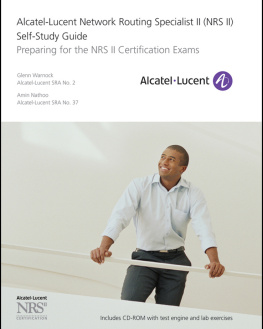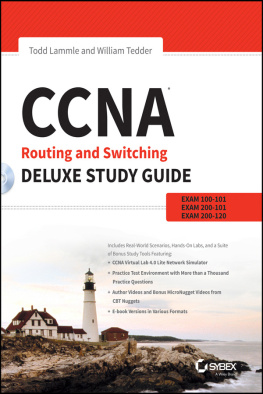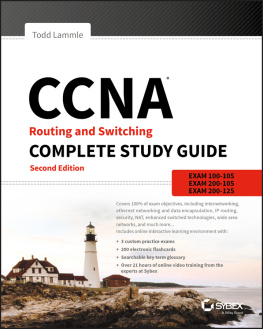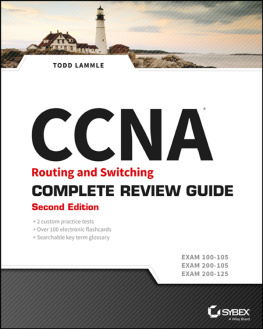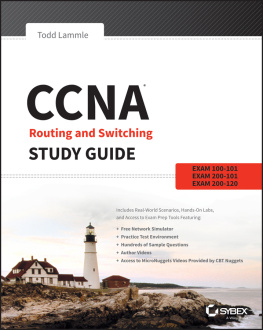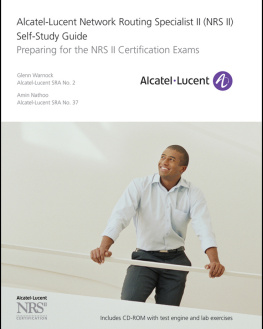Warnock Glenn Nathoo Amin - Alcatel-Lucent Network Routing Specialist II (NRS II) Self-Study Guide
Here you can read online Warnock Glenn Nathoo Amin - Alcatel-Lucent Network Routing Specialist II (NRS II) Self-Study Guide full text of the book (entire story) in english for free. Download pdf and epub, get meaning, cover and reviews about this ebook. year: 2011, publisher: John Wiley & Sons, genre: Home and family. Description of the work, (preface) as well as reviews are available. Best literature library LitArk.com created for fans of good reading and offers a wide selection of genres:
Romance novel
Science fiction
Adventure
Detective
Science
History
Home and family
Prose
Art
Politics
Computer
Non-fiction
Religion
Business
Children
Humor
Choose a favorite category and find really read worthwhile books. Enjoy immersion in the world of imagination, feel the emotions of the characters or learn something new for yourself, make an fascinating discovery.
- Book:Alcatel-Lucent Network Routing Specialist II (NRS II) Self-Study Guide
- Author:
- Publisher:John Wiley & Sons
- Genre:
- Year:2011
- Rating:4 / 5
- Favourites:Add to favourites
- Your mark:
- 80
- 1
- 2
- 3
- 4
- 5
Alcatel-Lucent Network Routing Specialist II (NRS II) Self-Study Guide: summary, description and annotation
We offer to read an annotation, description, summary or preface (depends on what the author of the book "Alcatel-Lucent Network Routing Specialist II (NRS II) Self-Study Guide" wrote himself). If you haven't found the necessary information about the book — write in the comments, we will try to find it.
Alcatel-Lucent Network Routing Specialist II (NRS II) Self-Study Guide — read online for free the complete book (whole text) full work
Below is the text of the book, divided by pages. System saving the place of the last page read, allows you to conveniently read the book "Alcatel-Lucent Network Routing Specialist II (NRS II) Self-Study Guide" online for free, without having to search again every time where you left off. Put a bookmark, and you can go to the page where you finished reading at any time.
Font size:
Interval:
Bookmark:

Part I: IP Networking
Chapter 1: IP/MPLS Service Networks
Chapter 2: Layer 2: The Physical Components of the Internet
Chapter 3: IP Networks
Chapter 4: Dynamic Routing Protocols
Chapter 5: Introduction to OSPF
Chapter 6: OSPF Multi-Area Networks
Chapter 7: OSPFv
Chapter 8: Introduction to IS-IS
Chapter 9: IS-IS Multi-Area Networks
Chapter 10: IS-IS for IPv
Chapter 1
IP/MPLS Service Networks
The Alcatel-Lucent NRS II exam topics covered in this chapter include the following:
- Characteristics of IP
- Internet overview
- Alcatel-Lucent 7750 Service Router product group
- 7750 Service Router
- 7705 Service Aggregation Router
- 7450 Ethernet Service Switch
- 7210 Service Access Switch
In this chapter, we describe the development of the Internet and the characteristics of the Internet protocol (IP). We see how IP networks have evolved and the requirements of networking technology today. Multiprotocol Label Switching (MPLS) addresses some of the limitations of IP networking and provides a foundation for building service networks. The chapter concludes with an overview of the Alcatel-Lucent Service Router product group.
1.1 Internet Protocol
Development of the Internet protocol (IP) started in 1974 and was formally defined in RFC 791 (Request for Comments for Internet Protocol) published in 1981. TCP/IP (Transmission Control Protocol/Internet Protocol) became the standard protocol of the ARPANET (Advanced Research Projects Agency Network) on January 1, 1983many consider this the birth of the Internet. The NSFNET (National Science Foundation Network) was created in 1986 with backbone links of 56 kb/s; these were soon upgraded to 1.5 Mb/s. Incredibly, today were deploying links that support 100,000 Mb/s, and were still using the same version of IP!
Characteristics of IP
The phenomenal growth of the Internet to date is to some extent a result of the characteristics of IP. Some of the characteristics that lead to IPs global dominance are the following:
- Simplicity This is the most important characteristic contributing to the success of IP. It means that new hardware and software supporting IP are easily developed, more easily deployed, and more easily managed. Simplicity also leads to lower cost, another characteristic of IP networks.
- Accessibility This is also a very important contributing factor to the success of IP. Development of the first Internet standards was an open and collaborative process, an approach that has continued to this day. All standards documents are freely available and usually easy to understand. In an age when the only question is whether to use IPv4 or IPv6, its easy to forget that 20 years ago there were many different communications protocols in use, and most were proprietary. The OSI (Open System Interconnect) protocols were open, but the standards documents were expensive, complex, and difficult to follow, making them much less accessible than IP.
- Resiliency This was one of the original design goals for IP and was achieved through the connectionless nature and simplicity of the protocol. IP routing protocols react quickly to changes in the network topology and simply change the next-hop to which they forward packets for a particular destination. It is understood that IP provides an unreliable, connectionless service, thus the higher-layer protocols provide connection-oriented features as required.
The simplicity of IP results in some serious limitations as the Internet reaches a size, complexity, and diversity of applications that was unimaginable to the early developers of the protocol. Some of the major shortcomings of IP include the following:
- Traffic engineering This is the ability to use a more sophisticated approach to routing traffic across the network. IP uses a simple hop-by-hop approach to forward traffic across the most direct path, but for todays networks and applications, this is often not the most suitable route. Traffic engineering allows for the use of other criteria and knowledge of the complete topology of the network to find an optimal path for a varied mix of traffic types.
- Quality of service (QoS) This is the ability to prioritize different traffic types and provide a different service level to each. Usually these service levels relate to delivery and delay guarantees. For example, a voice-over-IP application used for a real-time conversation requires a small delay and relatively low packet loss, whereas an e-mail application can tolerate much greater delay and can easily retransmit lost packets. A simple IP network provides the same level of service to all applications ( best effort ).
- High resiliency High resiliency, or high availability, goes beyond the resiliency of IP to provide connectivity that is nearly always on. We can build redundancy into a network with IP routing protocols so that most equipment failures result in an outage lasting only a few seconds. We hardly notice such an outage when surfing the Web or sending e-mails, but we are not nearly as tolerant when using IP-TV (broadcast television over IP) to watch our favorite sporting event. More demanding applications typically strive for failover in less than 50 milliseconds1/20 of a second.
- IPv4 address space The IPv4 address space is effectively exhausted. The number of devices connected to the Internet continues to grow exponentially, and every one needs a unique address. There are measures that have been developed to extend the IPv4 address space, but ultimately the increased address space of IPv6 is required.
QoS is a topic for another book, but this book addresses the other three issues listed above. A key technology in adding these capabilities to an IP network is Multiprotocol Label Switching (MPLS). We will see that MPLS is effectively a tunneling technology that allows us to build a variety of different networks using the base technology of an IP network.
Although the global, public Internet is the network that interconnects us all, in reality there is an even larger demand for private networks. These private networks may interconnect corporate enterprises to their different geographical locations or to their partners and customers. Or they may be used to deliver specific services in a controlled manner, such as mobile services or IP-TV delivery.
Service providers are increasingly adopting IP/MPLS networks to provide these private network services. IP/MPLS provides a cost-effective, flexible foundation for deploying a wide variety of private network services.
The Internet
The 1980s were really the experimental years of the Internet as it grew throughout universities and American research institutions. TCP/IP was included in the free UNIX distributions of the time, which definitely helped spread the understanding and use of TCP/IP. The fact that the RFC documents that define all Internet protocols are freely available and generally easy to understand also helped spread its acceptance. Key characteristics of the Internet in the 1980s were the following:
- Experimental nature of the Internet
- Development of IP routing software (IS-IS, OSPF, BGP)
- Routing typically handled by general-purpose mini-computers running routing software
During the 1990s, the Internet spread into the commercial world and a much broader public awareness. Major characteristics of this decade included the following:
- Development of the Hypertext Transfer Protocol (HTTP) and the World Wide Web
- Availability of high-speed Internet access using ADSL (Asymmetric Digital Subscriber Line) and cable networks
Font size:
Interval:
Bookmark:
Similar books «Alcatel-Lucent Network Routing Specialist II (NRS II) Self-Study Guide»
Look at similar books to Alcatel-Lucent Network Routing Specialist II (NRS II) Self-Study Guide. We have selected literature similar in name and meaning in the hope of providing readers with more options to find new, interesting, not yet read works.
Discussion, reviews of the book Alcatel-Lucent Network Routing Specialist II (NRS II) Self-Study Guide and just readers' own opinions. Leave your comments, write what you think about the work, its meaning or the main characters. Specify what exactly you liked and what you didn't like, and why you think so.

